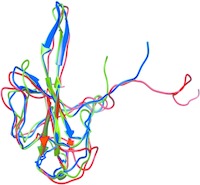Abstract
The N protein of coronaviruses is a multifunctional protein that is organized into several domains. The N‐terminal part is composed of an intrinsically disordered region (IDR) followed by a structured domain called the N‐terminal domain (NTD). In this study, the structure determination of the N‐terminal region of the MERS‐CoV N protein via X‐ray diffraction measurements is reported at a resolution of 2.4 Å. Since the first 30 amino acids were not resolved by X‐ray diffraction, the structural study was completed by a SAXS experiment to propose a structural model including the IDR. This model presents the N‐terminal region of the MERS‐CoV as a monomer that displays structural features in common with other coronavirus NTDs.
Keywords: MERS‐CoV, nucleocapsid, structure, SAXS, RNA‐binding domain
The structural characterization of the N‐terminal part of the nucleocapsid from Middle East respiratory syndrome coronavirus (MERS‐CoV), a recently emerging virus, is reported. The structure of the N‐terminal region, which includes a disordered tail followed by a globular domain, was obtained by combining X‐ray diffraction and SAXS.

The full text for this article, hosted at http://journals.iucr.org, is unavailable due to technical difficulties.
Supporting information
Supporting information for this article can be found http://scripts.iucr.org/cgi-bin/paper?mn5105
Associated Data
This section collects any data citations, data availability statements, or supplementary materials included in this article.
Supplementary Materials
Supporting information for this article can be found http://scripts.iucr.org/cgi-bin/paper?mn5105


